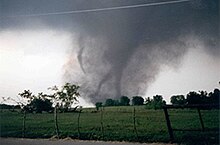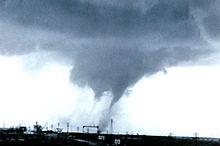Multiple-vortex tornado: Difference between revisions
m Fixing completely bare references Wikipedia:Bare_URLs |
m grammar |
||
| (32 intermediate revisions by 27 users not shown) | |||
| Line 1: | Line 1: | ||
{{Short description|Tornado comprising multiple vortices}} |
|||
[[File:Tushka, Oklahoma tornado April 14, 2011.jpg|thumb|A multiple-vortex tornado near [[Tushka, Oklahoma]], on April 14, 2011.]] |
|||
[[File:Dead Man Walking Jarrell 1997.jpg|thumb|The infamous photograph of the [[1997 Prairie Dell-Jarrell tornado|1997 Jarrell F5 tornado]], nicknamed the "Dead Man Walking Tornado" due to its sub-vortices appearing similar to the [[Death (personification)|grim reaper]] walking.]] |
|||
{{Use dmy dates|date=May 2023}} |
|||
[[File:1957 Dallas multi-vortex 1 edited.JPG|thumb|A multiple-vortex tornado outside [[Dallas, Texas]], on April 2, 1957.]] |
[[File:1957 Dallas multi-vortex 1 edited.JPG|thumb|A multiple-vortex tornado outside [[Dallas, Texas]], on April 2, 1957.]] |
||
A '''multiple-vortex tornado''' is a [[tornado]] that contains several vortices (called subvortices or suction vortices) revolving around, ''inside'' of, and as part of the main [[vortex]]. The only times multiple vortices may be visible are when the tornado is first forming or when condensation and debris are balanced such that subvortices are apparent without being obscured. They can add over 100 mph to the ground-relative wind in a tornado circulation and are responsible for most cases where narrow arcs of extreme destruction lie right next to weak damage within tornado paths.<ref>http://www.crh.noaa.gov/images/pah/pdf/elite/EliteSpotterWorkshopSlidesSection3.pdf {{ |
A '''multiple-vortex tornado''' is a [[tornado]] that contains several vortices (called subvortices or suction vortices) revolving around, ''inside'' of, and as part of the main [[vortex]]. The only times multiple vortices may be visible are when the tornado is first forming or when condensation and debris are balanced such that subvortices are apparent without being obscured. They can add over 100 mph to the ground-relative wind in a tornado circulation and are responsible for most cases where narrow arcs of extreme destruction lie right next to weak damage within tornado paths.<ref name="auto">[http://www.crh.noaa.gov/images/pah/pdf/elite/EliteSpotterWorkshopSlidesSection3.pdf Elite Spotter Workshop]crh.noaa.gov {{Webarchive|url=https://web.archive.org/web/20100808172002/http://www.crh.noaa.gov/images/pah/pdf/elite/EliteSpotterWorkshopSlidesSection3.pdf |date=8 August 2010 }}</ref> |
||
==General== |
==General== |
||
Suction vortices (or suction spots) are really substructures of many, perhaps all, tornadoes but are not always easily visible. These usually occur at the base of the tornado vortex where the tornado makes contact with the surface. Subvortices tend to form after vortex breakdown reaches the surface and are resultant from the ratio of cyclonically incoming and rising air motions. Multivortex structure is not unique to tornadoes, occurring in other circulations such as [[dust devil]]s, but is a natural result of the physics of vortex dynamics. |
Suction vortices (or suction spots) are really substructures of many, perhaps all, tornadoes but are not always easily visible. These usually occur at the base of the tornado vortex where the tornado makes contact with the surface. Subvortices tend to form after vortex breakdown reaches the surface and are resultant from the ratio of cyclonically incoming and rising air motions. Multivortex structure is not unique to tornadoes, occurring in other circulations such as [[dust devil]]s, but is a natural result of the physics of vortex dynamics.[[File:Tushka, Oklahoma tornado April 14, 2011.jpg|thumb|A multiple-vortex tornado near [[Tushka, Oklahoma]], on April 14, 2011.|left]]Multivortex tornadoes should not be confused with cyclically tornadic [[supercell]]s. These systems can have the tendency to produce many, and very separate tornadoes, called [[tornado family|tornado families]], existing either at the same time or in succession. A phenomenon similar in nature to multiple vortices is the [[satellite tornado]]. It is different from a multiple-vortex tornado in that it exists ''outside'' of the main tornado and forms via a different mechanism.<ref name="auto"/> |
||
Multivortex tornadoes should not be confused with cyclically tornadic [[supercell]]s. These systems can have the tendency to produce many, and very separate tornadoes, called [[tornado family|tornado families]], existing either at the same time or in succession. A phenomenon similar in nature to multiple vortices is the [[satellite tornado]]. It is different from a multiple-vortex tornado in that it exists ''outside'' of the main tornado and forms via a different mechanism.<ref>http://www.crh.noaa.gov/images/pah/pdf/elite/EliteSpotterWorkshopSlidesSection3.pdf {{Bare URL inline|date=November 2021}}</ref> |
|||
==Notable tornadoes== |
==Notable tornadoes== |
||
| ⚫ | The largest tornado ever documented was a multiple-vortex tornado. It struck [[2013 El Reno tornado|El Reno, Oklahoma, on May 31, 2013]], as a rain-wrapped tornado, taking the lives of tornado researcher [[Tim Samaras]], his son Paul, and their [[TWISTEX]] colleague, Carl Young. This storm also took the life of local amateur chaser, Richard Henderson.<ref>{{cite news |author=Clay, Nolan |date=June 3, 2013 |title=Oklahoma storms: Amateur storm chaser took photo of tornado that killed him |url=http://newsok.com/article/3841315 |archive-url=https://web.archive.org/web/20160309123922/http://newsok.com/article/3841315 |archive-date=2016-03-09 |access-date=June 4, 2013 |newspaper=[[The Oklahoman]]}}</ref> It had a maximum width of {{convert|2.6|mi|km|}} and a maximum recorded windspeed of at least {{convert|313|mph|kph|}}. However, because of a lack of intense property damage, the tornado achieved a rating of EF3 on the [[Enhanced Fujita scale]].<ref>{{cite journal|title=Some Considerations for the Use of High-Resolution Mobile Radar Data in Tornado Intensity Determination|author=Jeff Snyder|author2=H. B. Bluestein|journal=Weather Forecast|volume=29|issue=4|pages=799–827|year=2014|doi=10.1175/WAF-D-14-00026.1|bibcode=2014WtFor..29..799S|s2cid=122669043 |url=https://zenodo.org/record/1234617|doi-access=free}}</ref> Nevertheless, the El Reno tornado is one of the two strongest tornadoes ever recorded in terms of maximum wind speeds, the other being the [[1999 Bridge Creek–Moore tornado]] which doppler radar measured {{convert|321|mph|kph|}} mph, later revised to 301±20 mph. |
||
The destructive May 2011 [[Enhanced Fujita Scale|EF5]] [[2011 Joplin tornado|Joplin, Missouri tornado]] was an example of a multiple-vortex tornado.<ref>{{Cite web|url=http://www.cleveland.com/nation/index.ssf/2011/05/joplin_missouri_tornado_was_ra.html|title = Joplin, Missouri, tornado was rare 'multi-vortex' with multiple cyclones in funnel|date = 24 May 2011}}</ref> |
|||
The [[1997 Jarrell tornado|1997 Jarrell tornado]] was a multiple vortex tornado. The infamous “Dead Man Walking” photo of it was at a juvenile stage of subvortice development. |
|||
| ⚫ | The largest tornado ever documented was a multiple-vortex tornado. It struck [[2013 El Reno tornado|El Reno, Oklahoma, on May 31, 2013]], taking the lives of tornado researcher [[Tim Samaras]], his son Paul, and their [[TWISTEX]] colleague, Carl Young. This storm also took the life of local amateur chaser Richard Henderson.<ref>{{cite news|author=Clay, Nolan |
||
== See also == |
== See also == |
||
Revision as of 01:41, 16 July 2024


A multiple-vortex tornado is a tornado that contains several vortices (called subvortices or suction vortices) revolving around, inside of, and as part of the main vortex. The only times multiple vortices may be visible are when the tornado is first forming or when condensation and debris are balanced such that subvortices are apparent without being obscured. They can add over 100 mph to the ground-relative wind in a tornado circulation and are responsible for most cases where narrow arcs of extreme destruction lie right next to weak damage within tornado paths.[1]
Allgemein
Suction vortices (or suction spots) are really substructures of many, perhaps all, tornadoes but are not always easily visible. These usually occur at the base of the tornado vortex where the tornado makes contact with the surface. Subvortices tend to form after vortex breakdown reaches the surface and are resultant from the ratio of cyclonically incoming and rising air motions. Multivortex structure is not unique to tornadoes, occurring in other circulations such as dust devils, but is a natural result of the physics of vortex dynamics.

Multivortex tornadoes should not be confused with cyclically tornadic supercells. These systems can have the tendency to produce many, and very separate tornadoes, called tornado families, existing either at the same time or in succession. A phenomenon similar in nature to multiple vortices is the satellite tornado. It is different from a multiple-vortex tornado in that it exists outside of the main tornado and forms via a different mechanism.[1]
Notable tornadoes
The largest tornado ever documented was a multiple-vortex tornado. It struck El Reno, Oklahoma, on May 31, 2013, as a rain-wrapped tornado, taking the lives of tornado researcher Tim Samaras, his son Paul, and their TWISTEX colleague, Carl Young. This storm also took the life of local amateur chaser, Richard Henderson.[2] It had a maximum width of 2.6 miles (4.2 km) and a maximum recorded windspeed of at least 313 miles per hour (504 km/h). However, because of a lack of intense property damage, the tornado achieved a rating of EF3 on the Enhanced Fujita scale.[3] Nevertheless, the El Reno tornado is one of the two strongest tornadoes ever recorded in terms of maximum wind speeds, the other being the 1999 Bridge Creek–Moore tornado which doppler radar measured 321 miles per hour (517 km/h) mph, later revised to 301±20 mph.
The 1997 Jarrell tornado was a multiple vortex tornado. The infamous “Dead Man Walking” photo of it was at a juvenile stage of subvortice development.
See also
References
- ^ a b Elite Spotter Workshopcrh.noaa.gov Archived 8 August 2010 at the Wayback Machine
- ^ Clay, Nolan (3 June 2013). "Oklahoma storms: Amateur storm chaser took photo of tornado that killed him". The Oklahoman. Archived from the original on 9 March 2016. Retrieved 4 June 2013.
- ^ Jeff Snyder; H. B. Bluestein (2014). "Some Considerations for the Use of High-Resolution Mobile Radar Data in Tornado Intensity Determination". Weather Forecast. 29 (4): 799–827. Bibcode:2014WtFor..29..799S. doi:10.1175/WAF-D-14-00026.1. S2CID 122669043.
External links
- Multiple Vortex Tornado at the Online Tornado FAQ

